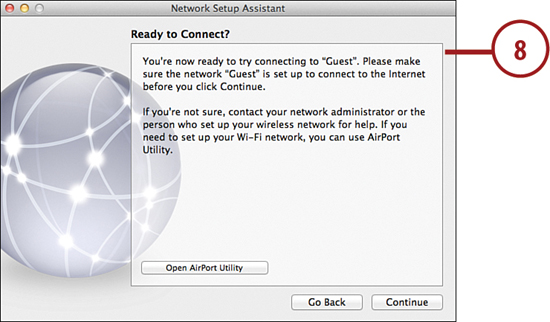3. Connecting Your MacBook to a Network
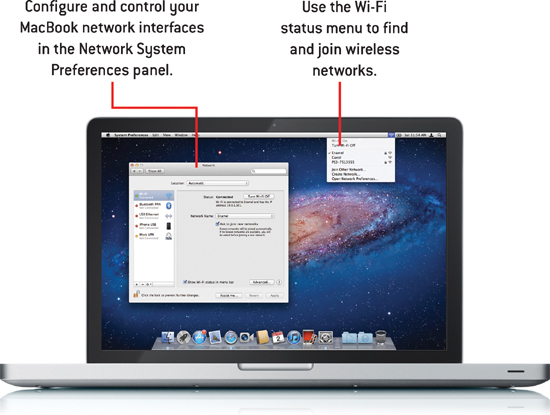
In this chapter, you’ll learn how to get your MacBook online including tasks like:
• Connecting to wired networks
• Connecting to secure wireless networks
• Configuring network address, DNS, and routing information
• Verifying network connections
• Tethering to an iPhone
• Using WWAN cards
• Creating VPN connections
• Managing multiple connections with Locations
Introduction
Being connected to a network gives you access to information, files, and services such as email or the web. Your MacBook can keep you connected whenever and wherever you are—from connecting to home and corporate networks to using cellular data cards and iPhone tethering, if there’s a network present, you can access it!
In this chapter, we explore the connection options available to you on your MacBook.
Connecting to a Wired Network
The most common type of network connection in the business world is a wired Ethernet connection. The cables used to connect to the network look like oversized phone connectors and, as luck has it, plug directly into your MacBook’s Ethernet port. (MacBook Air owners will need to buy Apple’s USB Ethernet adapter.) The MacBook supports gigabit Ethernet, making it capable of exchanging information at extremely high speeds.
Making an Ethernet (Wired) Connection
On a network that is set up to automatically configure your computer using DHCP, the most complicated thing you need to do is plug in the network cable!
1. Open the System Preferences panel and click the Network icon.
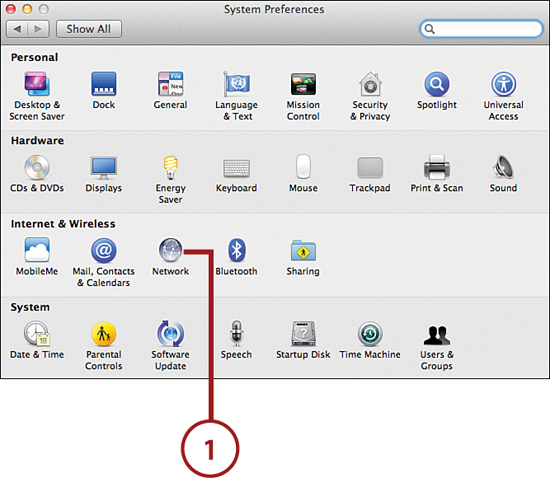
2. The network preference panel displays. All of the activate network interfaces are listed here. Red dots indicate that no connection is present on the interface.
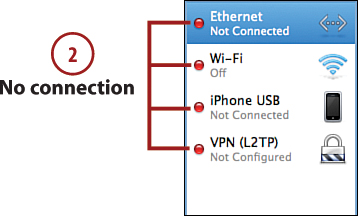
3. Plug the network cable into the left side of your MacBook.
4. After a few seconds, the interface should update, showing a green dot for an active connection. The pane to the right of the interfaces displays the information that your computer is using to communicate online.
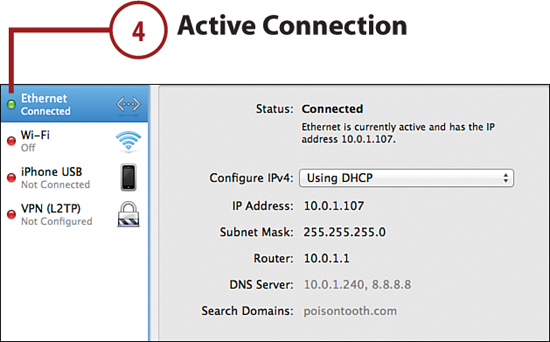
Connecting to a Wireless Network
You have a MacBook, presumably because you love the portability and flexibility to compute whenever and wherever you like. What goes better with a computer that you can carry around than a wireless network? Using the built-in AirPort wireless card in your computer, you can connect to almost any type of wireless network.
Making a Wireless Connection
Apple makes life easy. Your MacBook comes ready (and able) to connect to wireless networks with a minimal amount of fuss.
Finding and Connecting to a Network
By default, your MacBook’s WiFi (wireless) card is active and searching for networks that it can connect to.
1. If your MacBook finds an available network, it prompts you to make a connection.
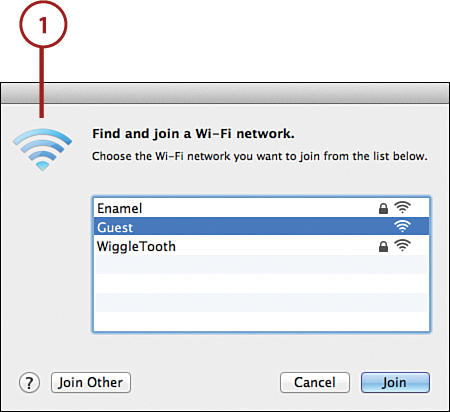
2. Choose the network name to connect to. Note that the network signal strength and security are denoted by icons to the right of the name. If a lock is present, the network requires authentication. This is covered in “Authenticating on a Wireless Network” later in this chapter.
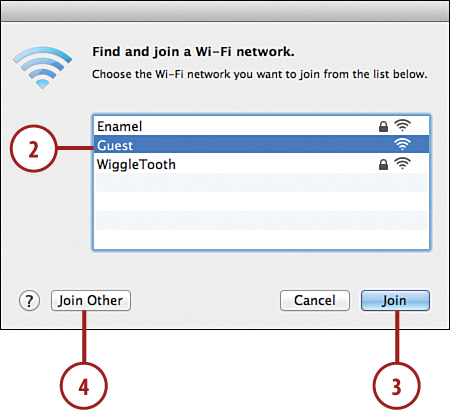
3. Click Join to connect to the selected network.
4. If you’ve been given the specific name of a network (called an SSID) by a network administrator and it doesn’t appear in the available networks list, click the Join Other button to enter the name and attempt to find the network.
Manually Choosing a Wireless Connection
If you want to manually choose a wireless network connection, you can use the Wi-Fi menu in your menu bar.
1. The Wi-Fi menu displays a list of all of the available wireless access points, their signal strengths, and their security requirements.
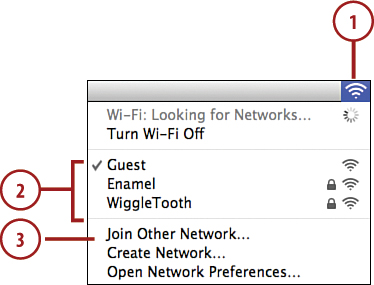
2. Choose the network name to which you wish to connect from the list. If you’re connecting to a network that shows a lock icon, it requires authentication. This topic is covered in “Authenticating on a Wireless Network” later in this chapter.
3. If you want to connect to a network using only its name, choose Join Other Network to enter the name and attempt the connection.
Authenticating on a Wireless Network
When your MacBook connects to an open (unsecured) network, it works immediately. If you’re connecting to a network that is secure, however, you need to authenticate, which means you need to provide a password or other identifying information. This requirement is usually denoted by a lock icon in the Network panel.
1. If you attempt to connect to a network that has a security requirement, you are prompted for a password.

2. Enter the password (or other information, depending on the security settings).
3. Click Show Password if you’d like to see the password instead of dots while you type.
4. To make sure that the network can be used again in the future without requiring that you retype the password, check the Remember This Network button.
5. Click Join to finish and authenticate to the network.
Disabling (and Enabling) Wireless Networking
Not everyone wants to have wireless networking always enabled. It can drain your battery faster and potentially open you up to network attacks on poorly secured wireless networks. Disabling the Wi-Fi network interface, and re-enabling it, is just a menu option away.
1. To disable the Wi-Fi card, choose Turn Wi-Fi Off from the Wi-Fi status menu.

2. The Wi-Fi menu updates to an outline of the usual multiline symbol. The Wi-Fi hardware is now powered down.

3. To re-enable the Wi-Fi card, choose Turn Wi-Fi On from the Wi-Fi status menu.
Manually Configuring Network Settings
Network connections, when automatically configured, seem to work almost like magic. Your computer finds a signal (wired or wireless), makes a connection, and everything just “works.” Behind the scenes, however, there are a handful of network settings that make this happen. If a network doesn’t support auto-configuration via DHCP, you need to make these settings manually.
What to Collect Before Proceeding
Your network administrator needs to provide the following settings in order to successfully manually set up your network:
• IP Address—A numerical address that uniquely identifies your computer.
• Subnet Mask—A value that helps your computer determine what network it is on.
• Router—The address of a device that moves network traffic between other local computers and remote networks (such as the Internet).
• DNS—The address of a device providing domain name lookups to your network. This service translates human-readable names (such as www.apple.com) into IP addresses and vice-versa.
• Proxy Settings—A device that sends and receives network traffic on your behalf, acting as a middleman for services.
Configuring TCP/IP and Proxy Settings
To manually change your TCP/IP and Proxy settings, follow these simple steps:
1. Open System Preferences and click the Network panel icon.
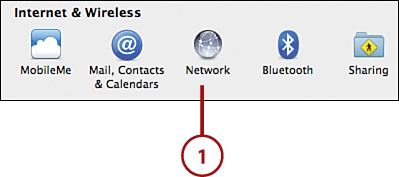
2. The network panel opens, showing all the available interfaces. Click the interface you wish to configure (usually Ethernet or Wi-Fi).
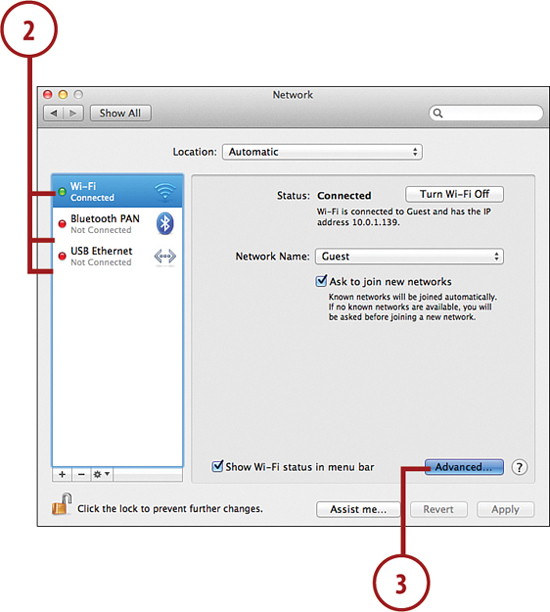
3. Click the Advanced button to view the full manual interface for network settings.
4. The Advanced configuration screen appears. Click TCP/IP in the button bar to access the common TCP/IP network settings.
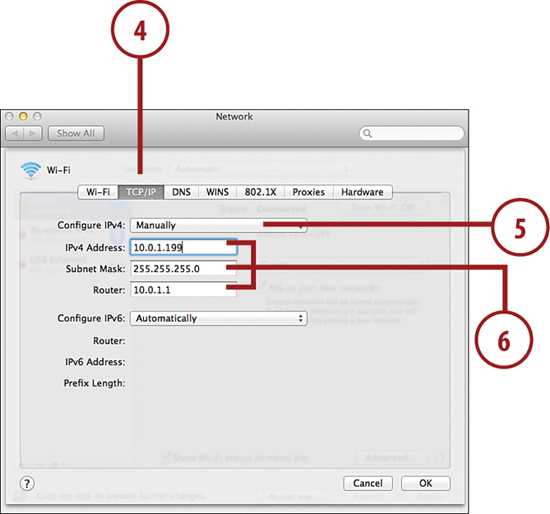
5. Use the Configure IPv4 drop-down menu to change your settings to be configured Manually.
6. Enter the IP address, Subnet Mask, and Router, as provided by your network administrator.
7. Click DNS in the button bar to change your domain name server settings.
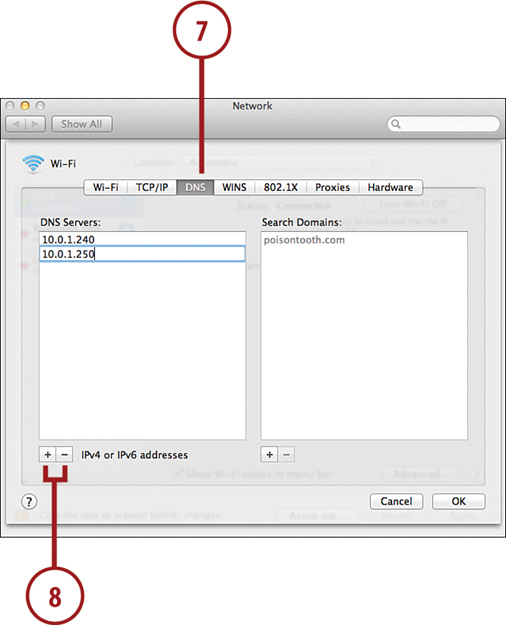
8. Click the + button below the DNS Servers list to add a new server to the list. Your ISP or network administrator usually provides at least two addresses to use; be sure to type it exactly as provided. (Use the – button to remove unused DNS Servers. Search Domains are not required unless specified by your administrator.)
9. If your network requires the use of a proxy, click the Proxies button in the button bar. If not, skip ahead to Step 13.
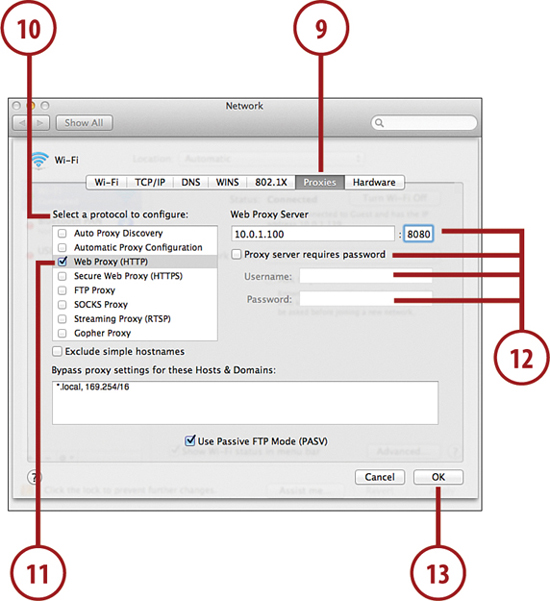
10. Click the checkboxes beside the protocols that you want to configure.
11. Click the protocol names to configure each proxy. Setup fields appear to the right of the protocol list.
12. Enter the proxy information as provided by your network administrator.
13. Click OK to exit advanced setup.
14. Click Apply to activate and begin using your new network settings.
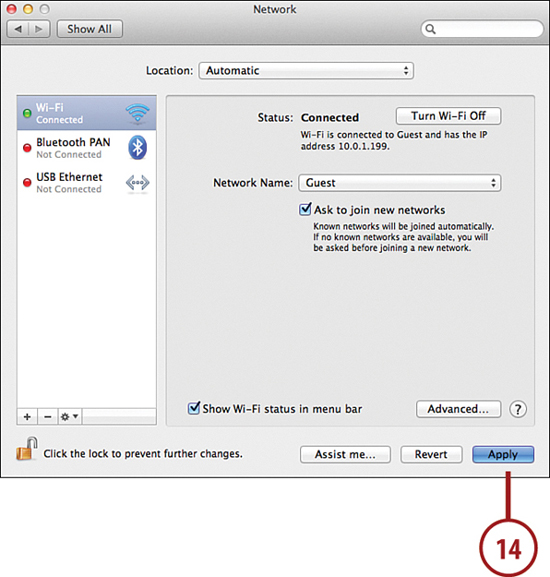
Activating PPPoE for DSL Connections
In some cases, most typically when using a DSL modem, you need to activate PPPoE (Point-to-Point Protocol over Ethernet) in order to make a connection.
1. Open System Preferences and click the Network panel icon.
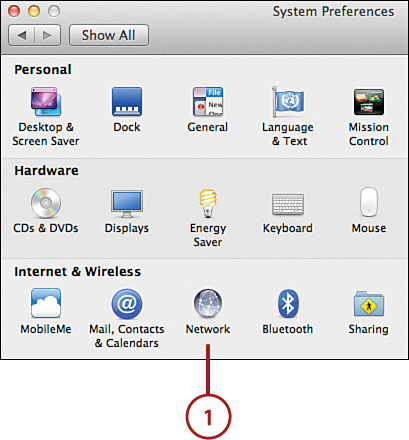
2. Select your active Ethernet Interface.
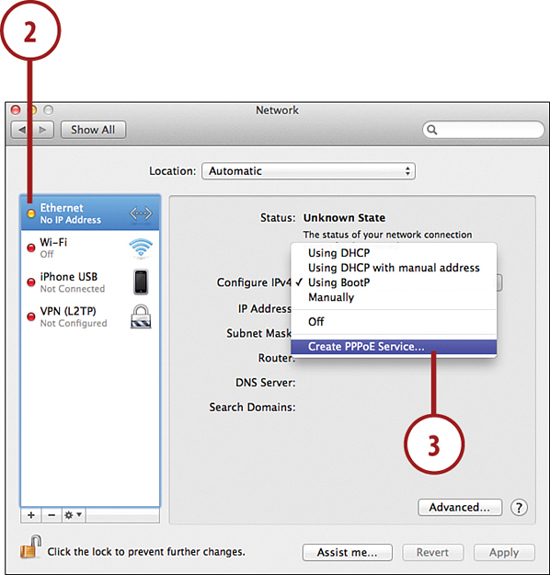
3. Choose Create PPPoE Service from the Configure IPv4 dropdown menu.
4. Choose a name for the connection. (The default, PPPoE, is fine.)
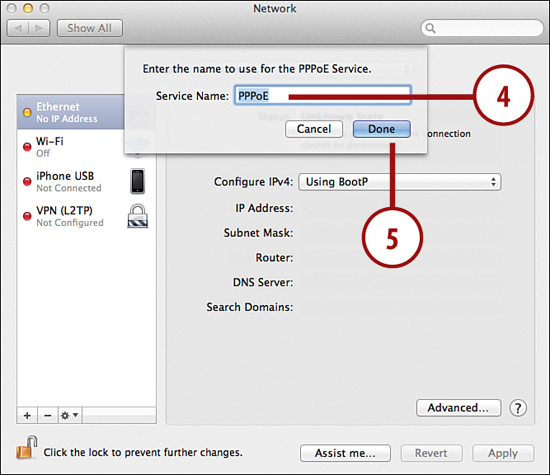
5. Click Done.
6. Enter the PPPoE information as provided by your ISP. Choose to remember the password if desired.
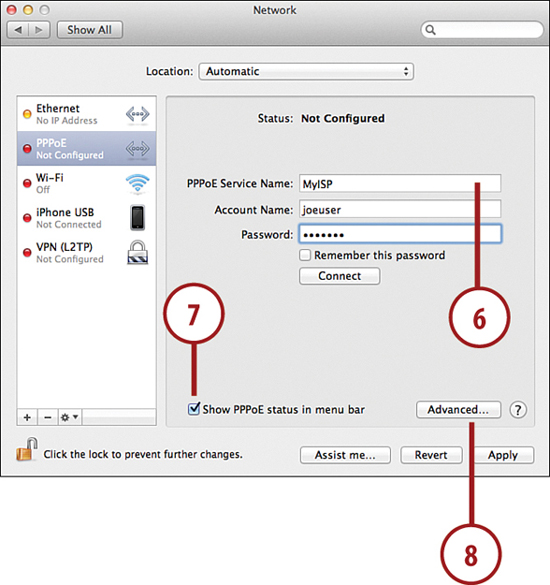
7. Click the Show PPPoE Status in Menu Bar checkbox to add a convenient menu option for connecting and disconnecting to the service.
8. Click the Advanced button.
9. Click PPP to open a variety of options for configuring your connection.

10. To help maintain a stable connection, check Connect Automatically When Needed and uncheck the Disconnect checkboxes if desired.
11. If required by your ISP, configure the TCP/IP settings manually as described in the “Configuring TCP/IP and Proxy Settings” task.
12. Click OK to close the Advanced settings.
13. Click Connect to begin using the PPPoE interface you’ve configured.
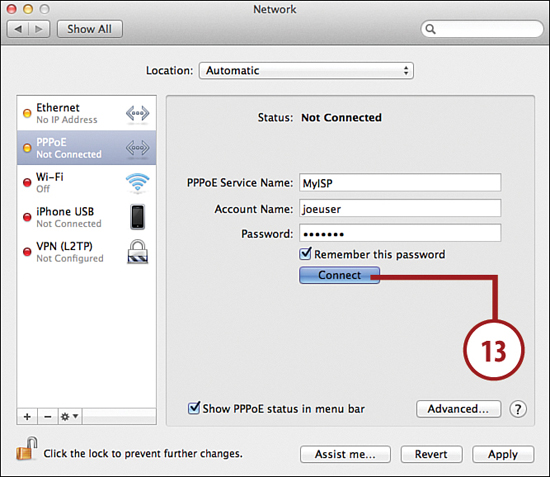
Making Mobile Connections with the iPhone and Cellular Data Cards
If you’re one of the millions of people with an iPhone or a cellular data card, also called a wireless wide area network (WWAN) network access card, chances are that you can use it (with the proper plan!) to access the Internet using your MacBook wherever you are. This process is called tethering and can be performed either wirelessly via Wi-Fi, Bluetooth, or through a direct (USB) connection to your MacBook.
Tethering Wirelessly to an iPhone Using Wi-Fi
To access the Internet wirelessly using your iPhone’s data services, you first need to subscribe to a tethering plan through AT&T or Verizon. Once your plan is ready, you have several options for how to connect your phone to your MacBook. If you have an iPhone 4 or newer, you can create a Wi-Fi hotspot to quickly get your MacBook and other Wi-Fi-ready devices online.
Enable tethering on the iPhone by following these steps:
1. Open the Settings application.
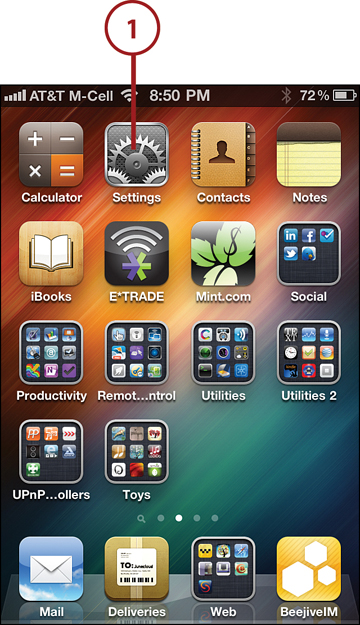
2. Choose Personal Hotspot.
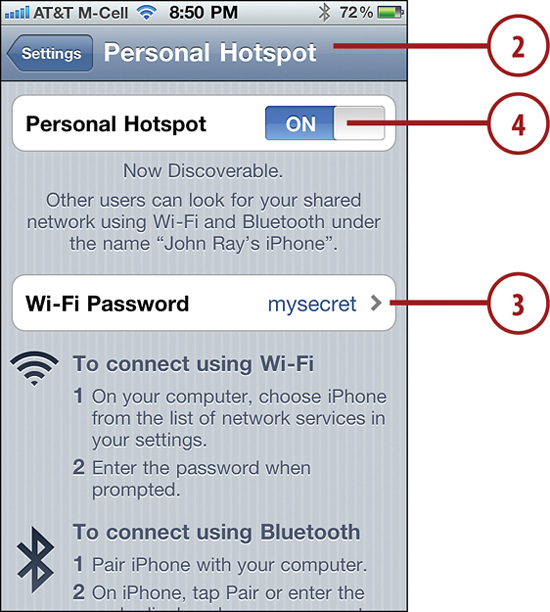
3. Enter a password you want to use to connect to your iPhone hotspot in the Wi-Fi Password field on the iPhone.
4. Turn Personal Hotspot ON using the switch in the iPhone interface.
5. After a few seconds, your Wi-Fi hotspot will be ready—it will be named using the name set for your iPhone. Follow the instructions described in “Making a Wireless Connection” earlier in this chapter to connect to the Wi-Fi hotspot.
Tethering Wirelessly to an iPhone Using Bluetooth
Another Internet access method is via Bluetooth. You will need to use this (or USB tethering), if you have an iPhone 3GS. Enable Bluetooth tethering by completing these actions:
1. Open the Settings application.
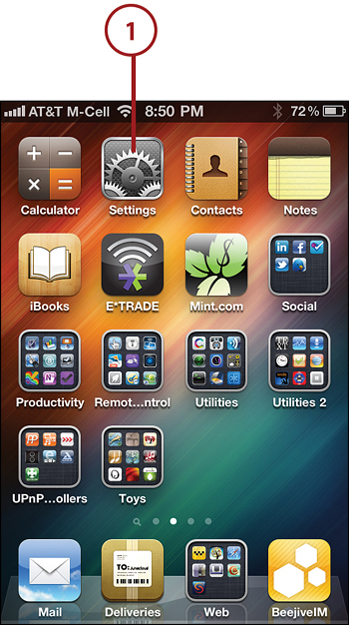
2. Choose Personal Hotspot.
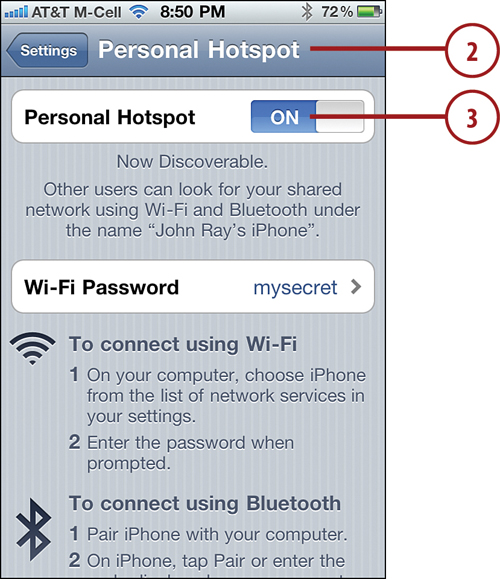
3. Turn Personal Hotspot ON using the switch in the iPhone interface.
4. Open the System Preferences application on your MacBook, and click the Bluetooth icon.
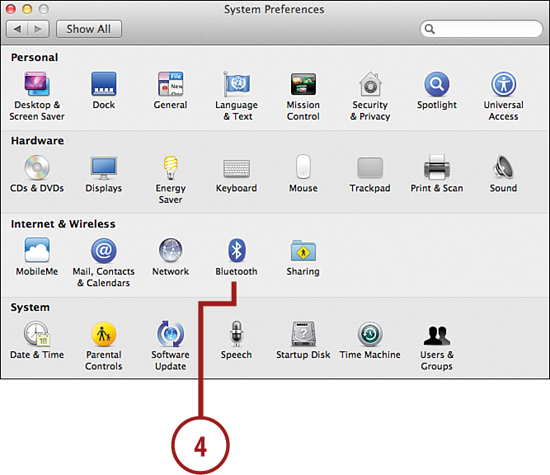
5. Make sure that Bluetooth is turned on.
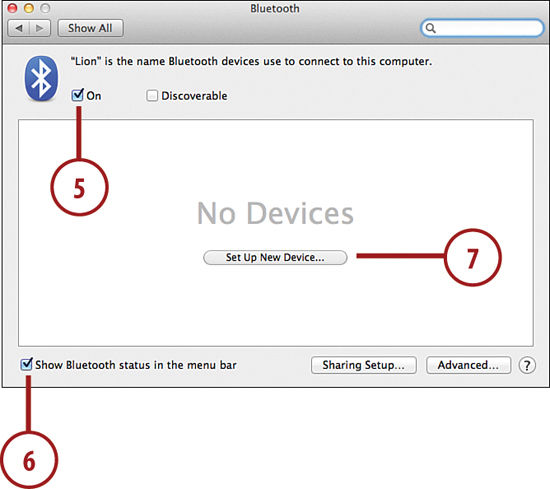
6. Click the Show Bluetooth Status in the Menu Bar checkbox. This provides a convenient place for you to disconnect and connect from the network through your iPhone.
7. Click the Set up New Device or + button to set up a new device. You need to “pair” your iPhone to your computer to use the iPhone’s Internet service. (Pairing is covered in depth in Chapter 10, “Connecting Devices to Your MacBook.”)
8. The Bluetooth Setup Assistant launches and searches for devices.
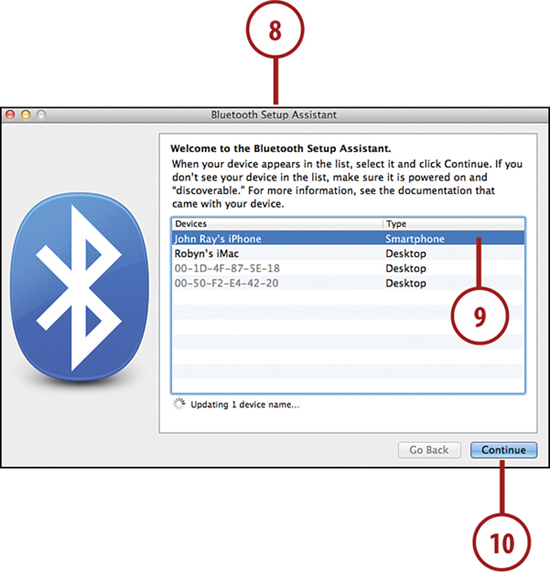
9. After a few seconds, the Bluetooth Setup Assistant displays an entry for your iPhone.
10. Make sure your iPhone is selected in the list and then click Continue.
11. The Setup Assistant provides a PIN and, simultaneously, you are prompted on your iPhone.
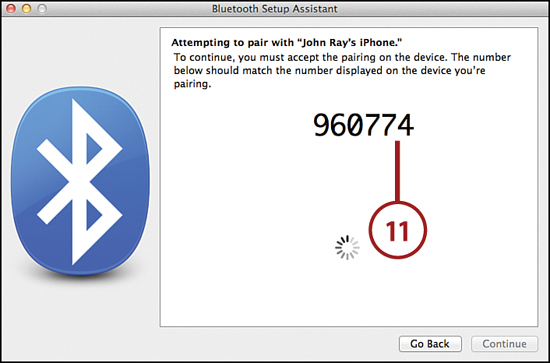
12. Confirm the PIN and tap the Pair button on the iPhone screen. The iPhone-specific setup is now complete.
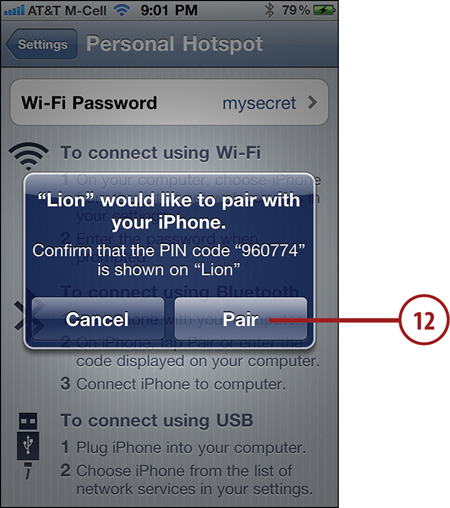
13. The Setup Assistant on your MacBook shows that setup was successful. Click the Quit button.
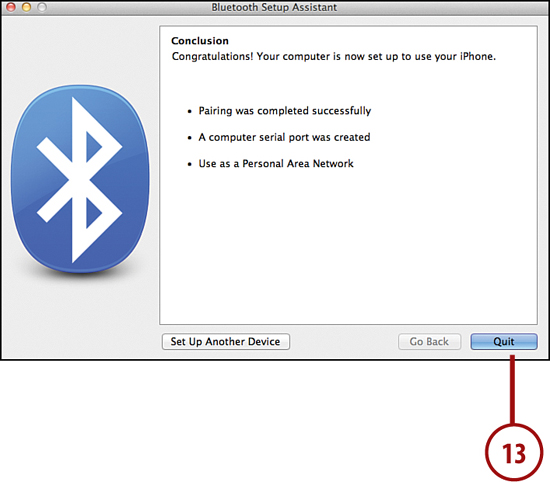
14. Open the System Preferences and click the Network Preferences button.
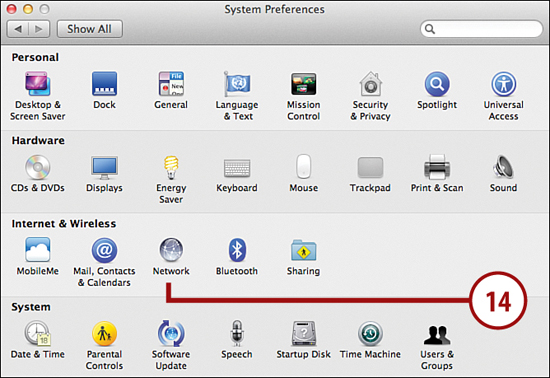
15. Select the Bluetooth PAN interface.
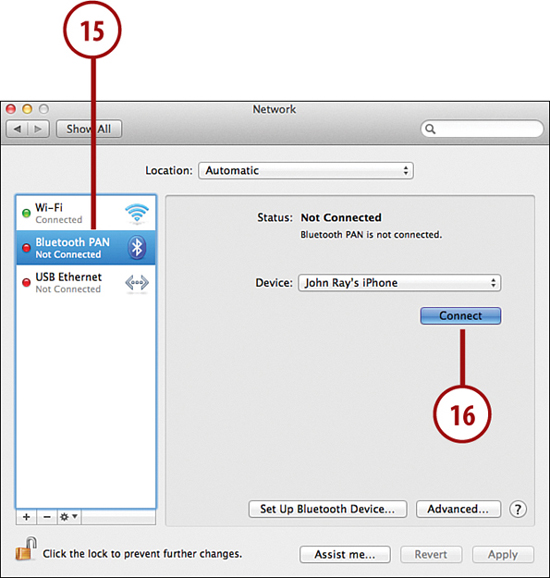
16. Click Connect to begin using your iPhone to access the Internet using your MacBook’s network.
Tethering with USB to an iPhone
If you find your iPhone low on power or are having signal strength problems with Bluetooth, you might want to use a USB connection to charge your phone and access the Internet simultaneously.
1. To tether to your iPhone via USB, make sure that iPhone Internet tethering is active (as described in “Tethering Wirelessly to an iPhone”).
2. Using an Apple iPhone cable, connect the iPhone to one of your MacBook’s unused USB ports.
3. Open the System Preferences and click the Network icon.
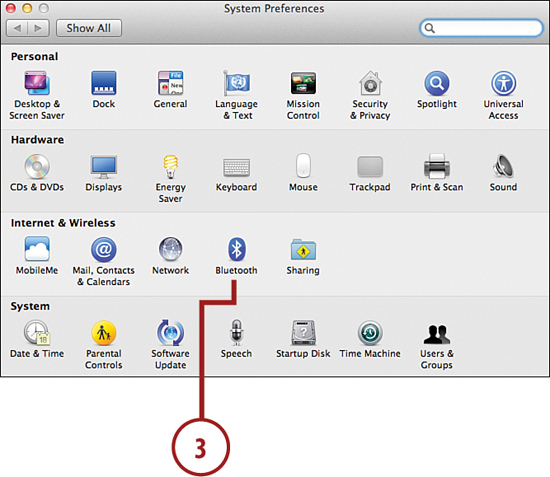
4. iPhone USB appears in the list of network interfaces. Click to select it.

5. Click Apply to connect and begin using the iPhone’s Internet connection on your computer.
6. To disconnect, unplug your iPhone.
Using Cellular Data Cards
If you don’t have an iPhone, you might want to use a cellular data card (WWAN card) to connect your MacBook to the Internet. There are a wide variety of WWAN cards that work out of the box on Snow Leopard.
Configuring a WWAN Card for Use with Your MacBook
Using a supported WWAN card is easy, as long as the card has been properly provisioned by your service provider!
1. Plug the WWAN card into your computer.
2. Open the Network System Preference panel.
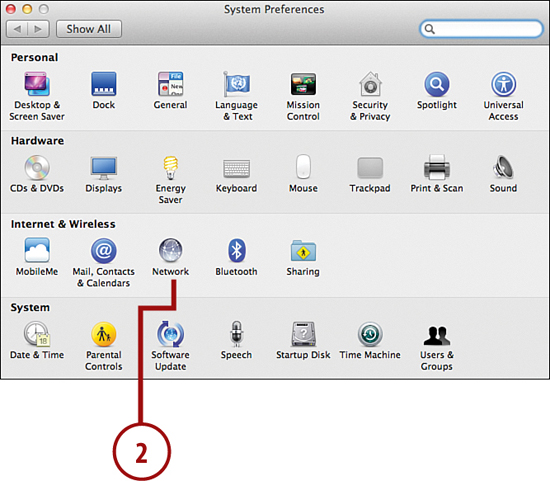
3. The Network Preference panel opens, showing the new device. Make sure it is selected in the interface list.
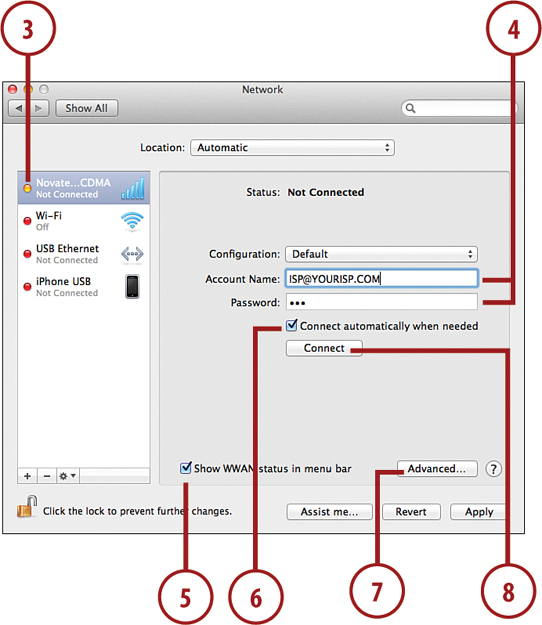
4. Configure the settings using the information provided by your ISP. In most cases, you won’t need to do anything.
5. Click the Show WWAN Status in Menu Bar button to display a menu item for the card.
6. Choose to connect automatically, if desired.
7. If you have been given specific network settings instructions by your ISP, click the Advanced button and enter the options as described in “Manually Configuring Network Settings.”
8. Click Connect to begin using your WWAN card.
Managing Your WWAN Connection
If you chose to add the WWAN status to your menu bar as described in the previous section, you can use it to monitor and manage your connection.
1. The WWAN menu bar displays the signal strength of your device.
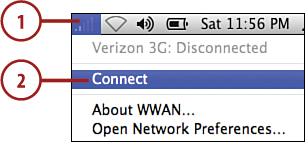
2. Use the Connect and Disconnect options under the menu to connect or disconnect from the Internet.
Creating Virtual Private Network Connections
With the MacBook, you have many different ways to connect to networks wherever you are. Many companies, however, only give you access to certain resources when you’re connected directly to their networks. This puts a small crimp on the idea of “working on the go.”
To get around the access problem, many organizations provide VPN, or Virtual Private Network, servers. Using a VPN server, your MacBook can use its current network connection (wireless, wired, through an iPhone, or using a WWAN card) to securely connect to your company’s network. You are able to access all of the same resources that you see when you’re sitting in your office chair.
Creating a VPN Connection
Snow Leopard supports three types of VPN connections—L2TP, PPTP, and Cisco IPSec. You need to find out from your network administrator which option is right for you, along with the settings you need to make the connection.
1. Create a new VPN connection by opening the System Preferences and clicking the Network icon.
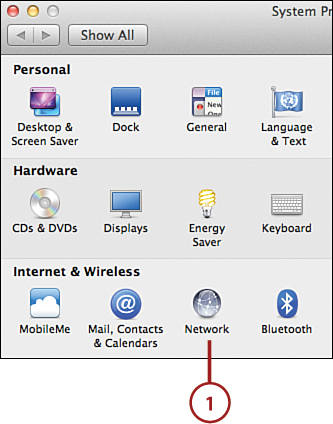
2. Click the + button at the bottom of the interfaces pane.
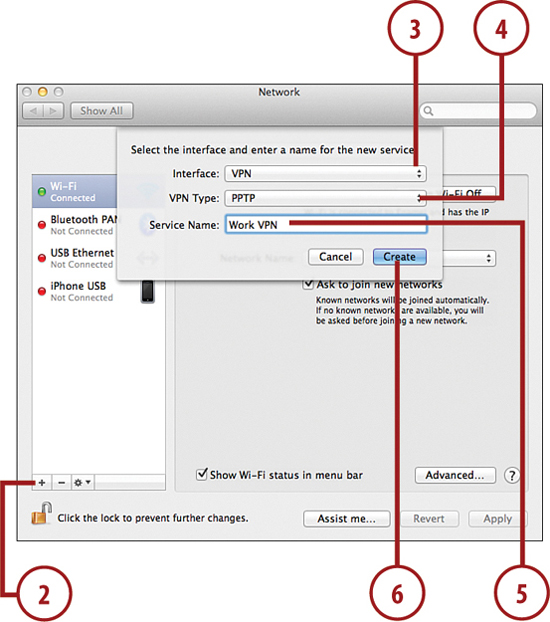
3. Choose VPN as the interface.
4. Set the VPN type to the type specified by your network administrator.
5. Enter a meaningful name for the VPN service, such as “Work VPN.”
6. Click Create.
7. A new VPN interface is created and added to the list of network interfaces. Make sure the VPN interface is highlighted.
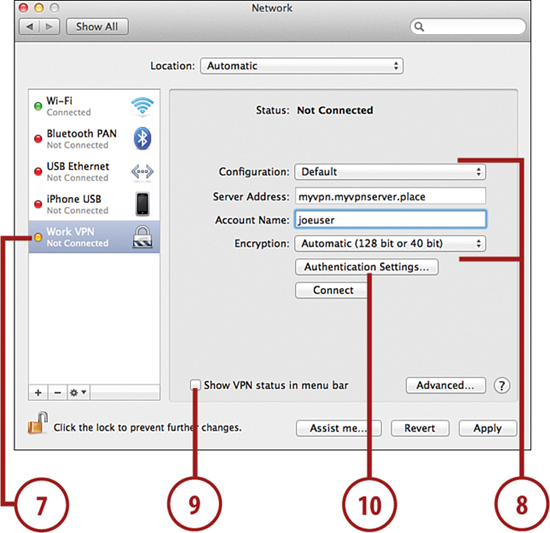
8. Configuration options appear on the right side of the network preference panel. Enter the server address and account information provided by your network administrator.
9. Click the Show VPN Status in Menu Bar item. This adds a menu item to the menu bar so you can quickly connect and disconnect from a VPN.
10. Click the Authentication Settings button.
11. You are prompted for a method of authentication. Enter a password or choose one of the other available options as directed by your network administrator
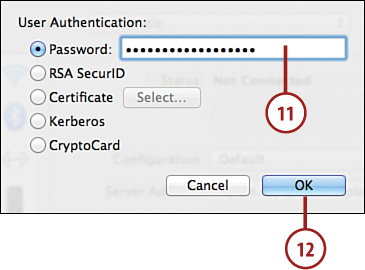
12. Click OK.
13. If you have been given specific network settings by your network administrator, click the Advanced button and enter the options as described in “Manually Configuring Network Settings.”
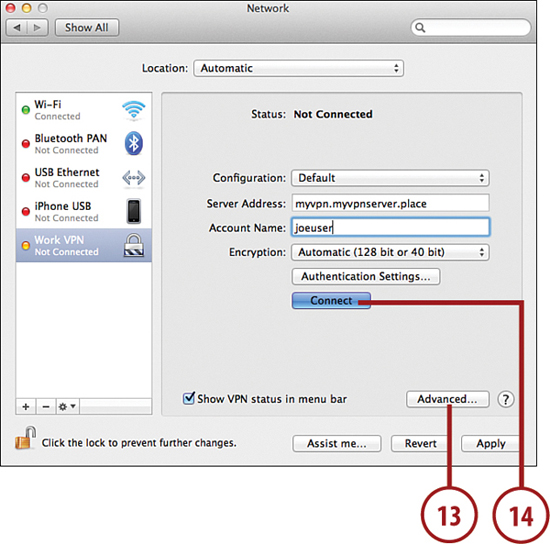
14. Click the Connect button to connect to the VPN.
Configuring VPN on Demand
VPNs, like cookies, are a “sometimes” thing. If you don’t need to have a VPN connection active, you shouldn’t because it slows down your computer and eats up resources on the VPN server itself. Snow Leopard provides a simple way to automatically connect to your VPN when you need it. If, for example, you try to access an intranet website, Snow Leopard detects what you’re doing and connects to your VPN server automatically.
1. To configure VPN on Demand service, open the System Preferences and click the Network icon.
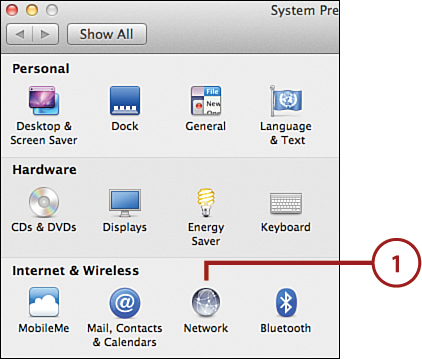
2. Highlight your VPN interface in the interface list.
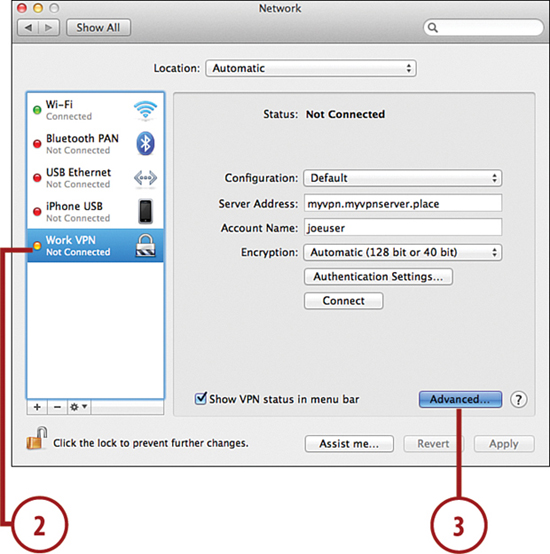
3. Click the Advanced button.
4. Click VPN on Demand in the button bar.
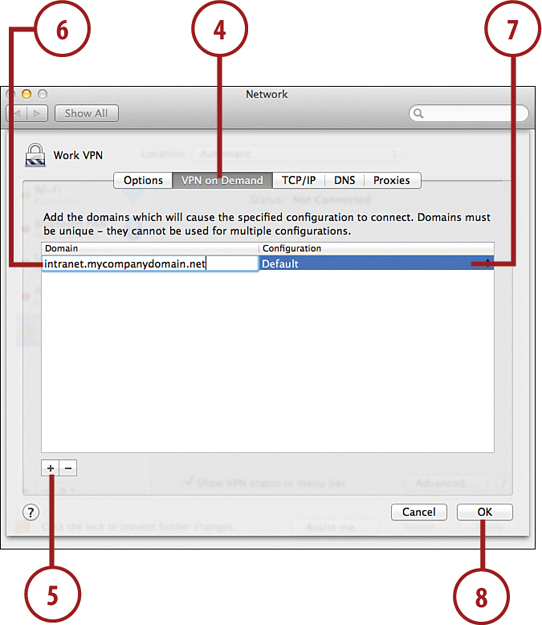
5. Click the + button to add a domain that triggers your VPN connection. (If you enter a domain you no longer want, remove it with the – button.)
6. Type the domain into the field that appears (for example, “intranet.mycompanydomain.net”).
7. If multiple configurations have been created (see the next section), you can choose a specific configuration to trigger when making the connection.
8. Click OK to finish setting up VPN on Demand.
Managing Multiple Connections with Locations and Configurations
If you have a MacBook, chances are you’re not one to sit still. One day you might be connecting from a beach in Maui, and the next, from a coffee shop in Columbus, Ohio. To help accommodate your mobile lifestyle, Apple provides two mechanisms for managing network connections: configurations and locations.
For interfaces such as VPNs, WWAN modems, or other devices that might have multiple different “versions” of their settings, you can create configurations. A configuration holds information such as the server you’re connecting to and your specific network settings.
Creating Configurations
To create a configuration, do the following:
1. To create a configuration (if supported by your network interface), first open the system preferences and click the Network icon.
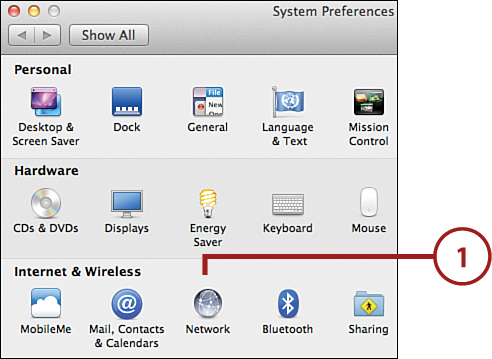
2. Click the interface for which you want to create a new configuration.
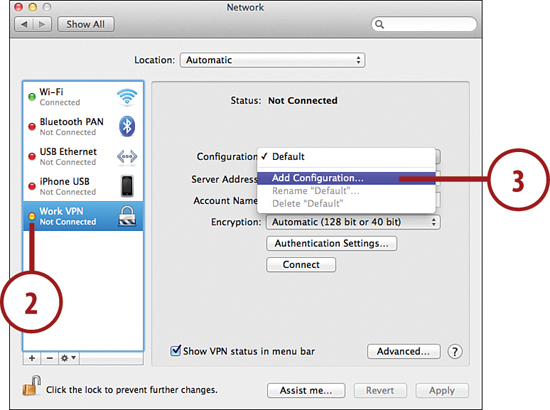
3. Using the Configuration popup menu, choose Add Configuration.
4. Enter a name for the configuration.

5. Click Create. You may now configure the network interface as described in the chapter.
6. Your new settings are stored and accessible under the configuration name you provided so that you can easily switch from one to another. (You can also remove or rename configurations under this menu.)

Adding and Using Locations
Locations are like configurations on steroids. Lots of steroids. Using locations, you can create entirely new sets of network interfaces and options and switch between them easily.
1. Open the System Preferences and click the Network icon.
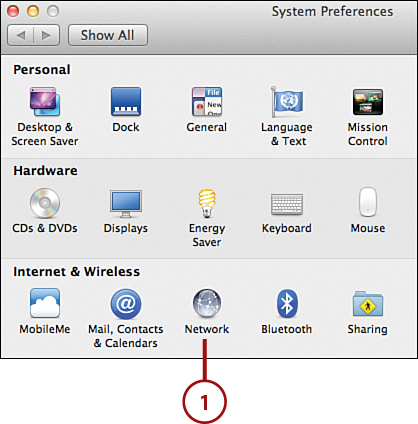
2. The default location of Automatic is set at the top of the network panel.
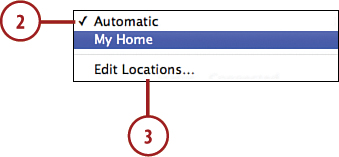
3. Choose Edit Locations from the Location drop-down menu.
4. A dialog box that lists any configured locations displays.
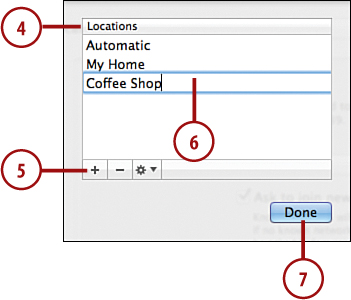
5. Click the + button to add an entry for a new location. (Use – to remove locations you no longer want.)
6. Type a name to describe the location, such as “Coffee Shop.”
7. Click Done.
8. All your network settings are now set to their defaults for the new location. All VPN connections and other interfaces are gone. You are, in effect, starting fresh with configuring your MacBook network setup.
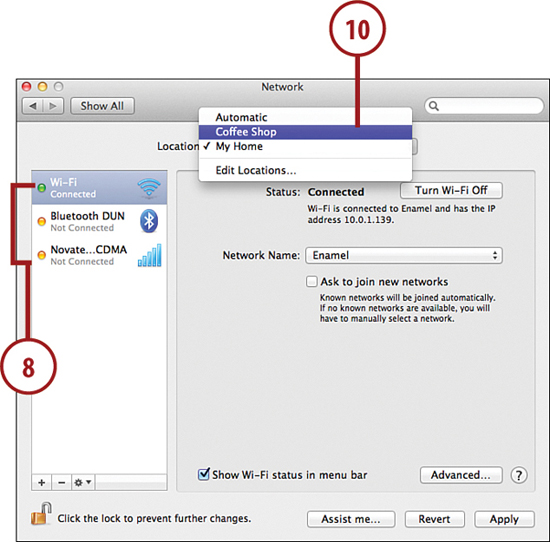
9. Configure your network settings as described in this chapter.
10. After you’ve completed your setup, you can switch between locations using the Location drop-down menu within the System Preferences Network panel. Remember that you can return to your original network settings by choosing the location named “Automatic.”
Seeking Automated Network Assistance
The Snow Leopard operating system provides a few automated tools to help you configure and diagnose your MacBook’s network settings. Be aware that the automated tools might not be able to fully set up your connection, and if you have complicated network configurations, you might want to manage the settings manually anyway. Let’s review what you need to do to use these tools.
Launching Diagnostics
To launch the diagnostics system, follow these steps:
1. Open the System Preferences Network panel and click the Network icon.
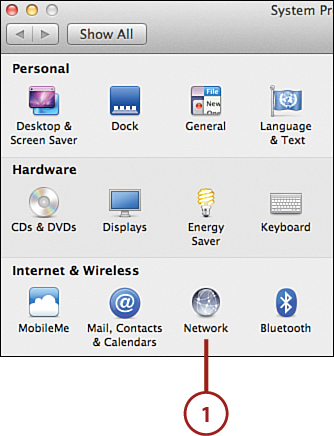
2. Click the Assist Me button at the bottom of the window.

3. Click Diagnostics in the dialog box that displays.
4. Choose the Network interface to run diagnostics on. If you’ve configured locations, you are first prompted to choose your location.

5. Click Continue.
6. Review the results and follow the onscreen instructions.
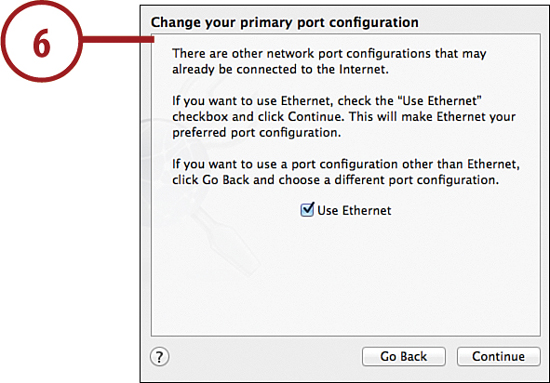
Launching the Setup Assistant
To launch the setup assistant, follow these steps:
1. Open the System Preferences Network panel and click the Network icon.
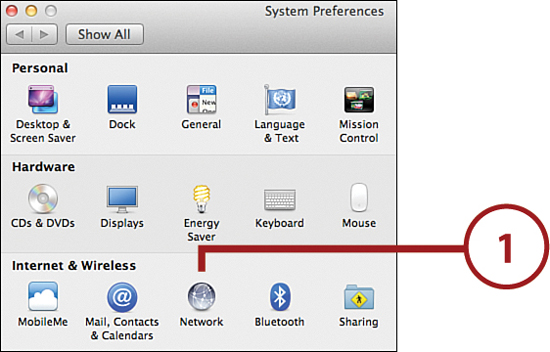
2. Click the Assist Me button at the bottom of the window.

3. Click Assistant in the dialog box that appears.
4. Provide a location where you will be using the network connection. This process creates a new location, as described in the previous “Using Locations” section.
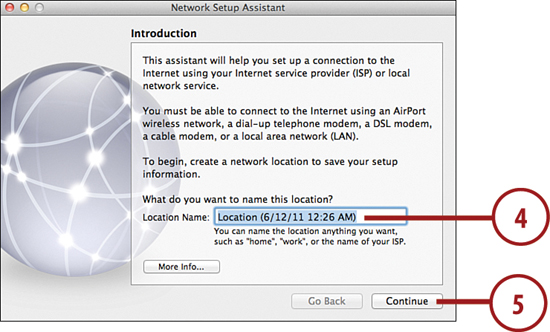
5. Click Continue.
6. Choose the type of connection you are making.
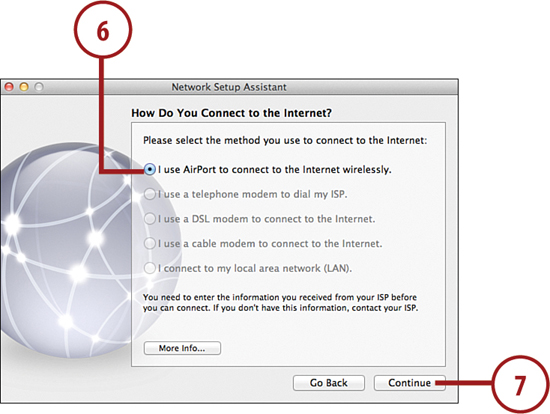
7. Click Continue.
8. Follow the onscreen instructions to let Snow Leopard attempt to configure your network settings for you.
